December is here and I am excited! The fishing in Tasmania has been kicking off over the last couple of months, but December is when it really starts to ramp up across the board.
In a year when seasons have been completely topsy-turvy, I am hesitant to make any bold statements. However, December is when I start to get excited about mako sharks and striped tuna. Who gets excited about striped tuna? I do! They are fantastic for a number of reasons and this month, I will outline why.
We will also go into some mako techniques and where to target them. With this style fishing berley is essential, so we will also touch on that. Mako sharks are our adrenalin fish here in Tasmania and there is plenty of that on tap when you see and hook one. Hooking the tasty grey torpedos is just the start of the adventure and we will go through some tips to keep everything under control and safe.
Yes it’s getting a damn site warmer in December, but that heat can bring sea breezes that can be a pain to our fishing for the month.
The schools of Australian salmon have been fantastic in the past few months with November seeing some bigger units find their way off the North West coast. December has us wondering and hoping there may be some yellowtail kingfish under and with them, so we will touch on those.
Snapper are filling anglers’ minds, and with the holiday season approaching we will have a look at spots to target them around the state.
Speaking of around the state, let’s have a quick look at what’s biting and where we might expect to find some fish.
Montague and the Stanley area are jewels in the crown of the North West coast and a closely guarded secret. I like my house not burnt to the ground so I won’t go into any great detail. The fishing on its day is spectacular and the fish across all species are Jurassic. What I mean by that is they seem to be all oversized.
Gummy sharks provide good fun and great table fare out the front right across the region. A keen angler with good knowledge of his or her sounder will pick up some very interesting ground that may be of interest. The interest here will be in trying for some snapper or yellowtail kingies around the tide changes. These fish love a bit of water movement. This is where I must also point out that the area has a lot of water movement. The tidal flows are significant so make sure you respect that and be very mindful should you venture that way.
King George whiting and blue-spot flathead can be targeted in the sandy shallows in and around the Montague and Stanley areas. They will surprise you where they can turn up and using soft plastics with an active tail will bring them undone. Don’t be scared to use an action on your plastic that kicks up a bit of sand and pause. The inlets as you go into Stanley are great places to target salmon and flathead, but again be wary of the tide.
Targeting whiting has been really stepping up of late in Tasmania. The age old and traditional method of fishing at anchor with a fine berley trail still holds true. Be sure to use a rig specifically for whiting, as they have small mouths and at times are known to be finicky feeders.
Whiting on soft plastics is becoming more and more popular and the plastics with a worm like nature and a finesse tails seem to do well. Topwater fishing for whiting in the shallows is also a new passion for some, and while I have never had a go myself, I can see the allure. We can’t all afford a fancy trip abroad chasing bonefish in Aitutaki. Whiting in the shallows on lures or fly could be the poor mans’ bonefish!
Sisters Beach and the Wynyard area can expect the flathead to move in to shallower depths and on most days of good weather a couple of drifts will find them. If the weather is fantastic and sea conditions favourable, heading out to some deeper water can find some tiger flathead to play with.
In closer and the southern calamari can still be found back up to Rocky Cape and right through to Doctors Rocks and Emu Bay.
Gummy sharks will be lurking in good numbers so if fishing for flathead and you find one put a mark on your sounder for next time to come out and target specifically.
The shallower areas around the base of Table Cape and the grounds seaward to 20m will also be areas where a concerted effort will find snapper. Using your sounder to find hard wrasse style bottom that transitions to a patch of rubble or sand will be the spot to start. These fish need some preparation and a good amount of patience. It’s going to take a few trips, so tough it out and you will eventually crack the code.
To get started, you should anchor and start a berley trail. We like to attach a medium sized berley bucket to a light rope and once the boat has settled back on the anchor drop it down vertically. Cast your lines out in a fan shape at the stern and place them in a rod holder. AT this point we usually start to send out your pre cut cubes of fish flesh. Just a little bit at a time. You can use pilchards from a tackle store of some fish pieces you have in the freezer of past catches. Thumb nail-size pieces with the odd bigger one every now and then is the way to go.
While you are waiting for a snapper to buckle your rod, you can cast a soft plastic out and work it back to the boat. The 4 and 3” Berkley Gulp Nemisis is prime for this.
In the rod holders at 90° to the boat, you can also use a rod with a snapper catcher rig and allow the boat’s movement to work the attractors. Your boat may well look like a porcupine from afar but you will be maximising your attack and prospecting effort.
The coastal towns of Ulverstone and Devonport come alive in December and offer similar fishing to that further along the coast. They are both situated on rivers that hold trout in the upper reaches and multiple species in their estuaries.
Ulverstone can be a good spot for spinning for salmon on both the west and east breakwaters. I find half tide on the incoming is best, and also the start of the run-out. The blue seawater filling the river will slow the rivers natural outgoing current and the salmon will be looking to feed.
A longer rod of 2m or more is best with lighter braid or mono to 10kg. This will allow you to cast a long way, but also be in the game should something better grab your slice lure or soft plastic. Covering some ground with your lure is the key and starting up against the bank and working around at 20° increments until you’re up against the other shore. Varying your rod tip height will allow you to work the deeper water when down low and avoid snags when working shallower water. Change your retrieve speed from time to time and vary between a slow roll wobble and a quicker fleeing bait speed.
Devonport has similar areas at its river mouth to cast for Australian salmon and often has some big schools in the area in December. They can also be accessed by boat and provide great sport. The area around the Bluff is a hot spot for fishing. Always be careful when fishing from the bank, and even more careful when fishing from the rocks.
The squid are in abundance in these spots as well; so always have a few jigs on hand.
The Bluff area and the rocks to the west are a great place to rock hop and in calm sea conditions can be rewarding. It is a platform to hone your rock fishing skills and use some more advanced techniques to find fish.
Up the Mersey River further the family friendly area around Horsehead creek can provide hours of fun for kids and on occasion supply some fish of decent size for the table. The deeper water can have a strong current flow, so heavy sinkers should be on hand. Target species include salmon, flathead, silver trevally and cod.
The Tamar area has been fishing well and all areas will fire in December. This is the traditional home of snapper in Tasmania, and the bigger reds feature early in the season in the shallower water. The school-sized fish tend to swarm up later in the month.
King George whiting are found in good numbers in and around the estuary at Low Head. Low Head is a squid hot spot and spoke to local Brett Johnstone, who shared some of his experiences.
The summer days are slowly appearing. The days are getting warmer, and if you’re hoping to target squid this summer here are a few small tips to improve your squid fishing.
Firstly, spend the money on a quality squid jig. The cheap jigs ($2-5) may look good, however, paying that extra $15-20 will ensure they have a good swim in the water and that they sink perfectly.
Paired up with a low diameter 8-10lb fluorocarbon, your chances of catching a squid will increase dramatically. Squid have incredibly good eyesight and I have consistently out fished anglers using 20lb mono.
When targeting squid, search for good weed beds. Low Head break wall is a common place to catch squid for the shore-based anglers. Other places include Kelso Beach and also Clarence Point (Garden Island). Sunset and sunrise provide the best fishing for squid, as this is their most common feeding time. For maximum catch rates, try to match the sunrise or sunset with the top of a tide.
When fishing for squid cast your lure and allow the jig to sink deep. Many anglers don’t often allow enough time for the lure to sink into the strike zone. Once the jig is sitting on the bottom, slowly raise the rod tip and bounce the jig 50-60cm off the bottom once or twice.
Raising the jig off the bottom and giving it action will allow squid in the area to see your lure and come chasing. As the lure glides back to the bottom, squid will usually attack the jig and hook up. Ensure to keep constant pressure on the jig as squid have very soft flesh and when given slack line, they unhook easily.
So there you go, follow a few of these little tricks and hopefully you will have a feed of calamari in no time.
Georges Bay will fire and any visit to St Helens should include a rod and reel in the car. A weekend away in the coastal village will not disappoint and there are plenty of options available.
Land-based fishos have a great deal of options from the many beaches or rocky shores. Boat anglers love the bay for its variety of species; it really is amazing.
The bream and silver trevally fishing is a genuine highlight. High up on the flats, in and around the oyster racks and in the deeper water will give soft plastic addicts a buzz.
On the Northern side on high tide, there are some bays where the salmon fishing is tremendous. Late arvo and into the daylight savings evening they can come up and feed with gusto. Little kids and big kids (like me) get excited as they smash the surface in big numbers. Heading over and gaining position on them, trying not to spook them, is crucial. No need to get fancy here. Light gear and the good old-fashioned metal slice lure. Cast your offering over the back of them, whip it through, and it’s go time! It’s super fun on the lighter gear as they get some good sized models in the bay. If for some reason you don’t have any luck on the slice, step it up a gear and slow roll a 4 or 3” Berkely Gulp Nemisis in the colour bleak. The salmon will be slashing across the water to get at the thing. Get in store and check them out for yourselves.
Whiting and garfish will keep anglers on their toes and those who use berley and dedicated hooks for the task will do quite well. Both species have small mouths as mentioned before and the use of small long shank hooks will increase your catch rates.
The beach fishing from The Gardens area can be sensational with a mixed bag of species. There are also plenty of spots to try a bit of beach fishing to the north all the way down to Scamander. Heading up the river at Scamander and the bream are there. It’s finding where they are that will keep you on your toes. They could be high up the river in the deeper sections or sprawled out down towards the shallows. Keep looking and don’t get despondent, they are there.
Offshore at St Helens and anglers will be looking for striped trumpeter and further out on the shelf for blue eye trevalla. Deep sea rigs with 3 circle hooks and big eggbeater spinning reels get the job done. Alvey reels and deck winches are a great way to go if you don’t have access to electric reels. It’s a big day fishing for blue head in deep water with 8000 or bigger sized reels and it’s easy to see why electrics have found favour. Even the most arduous traditionalist will be saying “so show me how this electric reel works?” should there be one on board.
Mako sharks and albacore will be on everyone’s mind and news they have arrived will motivate the masses. It’s a little early in December for them.
Bicheno is a coastal destination that offers so many jewels that often go unnoticed to most. There are a number of things in this little towns favour. The shopping centre is close to the accommodation and the accommodation is close to the boat ramp, in turn the boat ramp is close to the shelf. Everything is close.
The shelf is not the only reason to hit Bicheno for a weekend of fishing, but it does hold some attraction. Albacore at this time of year will be on the shelf but putting lures in just after the 100m mark may have you find some fish. We like to troll towards the shelf and look for any surface action as we go. Hitting the shelf at 90° as it runs north to south will have you in the deep water and hopefully finding a temperature break or current holding albacore. They’rereat sport and eating, just remember to bleed them as soon as you can and place in an ice slurry if possible. Like most fish, if looked after right from the time they hit the deck, the eating quality is tenfold from something that has laid out in the sun with its guts in all day. If you are working a patch over in a smaller area, cleaning them on the go and placing the fillets in the esky can have a mako turn up out of the blue. This has happened to us a number of times and always makes for a good day out. Albacore and mako in the fridge is a great result.
Tiger flathead are in good numbers off Bicheno and seem to hoard up at this time of year. Last year we pulled up on some really good-looking sounder readings that I had picked for some possible stripey trumpeter. It turned out to be a big cluster of big sized tigers.
The massive amount of waterways available to the south continues to amaze me as we fish and find more and more fantastic areas. Steaming out of Triabunna and heading south through Mercury passage, you will be driving past many areas that are worth a fish. Moving between the mainland of Tasmania on your right and Maria Island on your left has you traversing over and past bays and sandy areas that hold a great number of fish.
Drifting for flathead will turn over the odd gummy shark and keep you on you toes, as kingfish have a fascination for just rocking up and saying “hello boat”. I always have a rod with an unweighted bait ready to go or a soft plastic with plenty of tail action. The bait for this is a squid tentacle or long silver slither of fish fillet.
Smaller boats looking to find a feed of flatties can find them in Fredrick Henry Bay. We usually launch from the beach at Lauderdale to the Eastern end of Ralphs Bay canal, or another beach launch at Cremorne. Across the other side of the bay there are also a number of launch options at Dodges Ferry and Primrose Sands.
The weather will mean more boats on the water and more people looking to find something of interest. More eyes scouring the water surface for a bird feed or dolphins with some bait bailed up. These things will give December a real good chance of being the month the albacore turn up.
Albacore time is generally a little bit later in the year, but we’ve already seen a few amberjack. Yes, that’s right, amberjack are turning up and being caught on the East Coast at Ansons Bay in November, who knows what may happen! I am going to stick my neck out and make a big call. The added interest in game fishing currently and with all the exciting captures of last year I am going to call game fishing season 2016 as an absolute belter.
The broadbill swords will be right on peoples’ minds and with some holiday leave and a bit of time on the water, expect to see some captures late December.
Mako sharks will be what it’s all about offshore right now as we scream towards the end of another year and look forward to having a visit from Santa.
You have seen a lot written about mako shark fishing and I have shared some details before on these pages. The new season is coming and I thought I might pair it down and make it simple for all to understand. Tasmania is very lucky to have a great mako shark fishery and to keep it we must only take what we can eat and look at tagging, or just simply release after a few photos. This will be a simple overview, but buy following it will hold you in good stead to come across something to dance with within a few trips.
It’s a must. It’s a cornerstone of attracting a shark to your boat. You will have a heap of people that say they have some good marks for mako, but these are not crucial. What is crucial is the amount of berley and the quality of it.
You can purchase berley from tackle stores or you can make your own. Some people get right into it and build all sorts of crazy berley making machines.
The other option is to have some whole fish like salmon and striped tuna kept from previous trips and frozen in the freezer. Take them out the night before and have them soft enough to break down by hand on the bait board and cut up into the finest cubes. You will find that the resultant ‘goop’ and cubes you have made will be a great start. This is hard work and is probably reason why the processed stuff you can buy is a popular choice.
Any combination of these can be used as you will need a lot berley to put together a decent trail. Do not also forget the tried and true method of the manual berley pot on the back of the transom.
The amount of berley you will need will depend on where you decide to try your luck. I say luck, as with any fishing, there is a fair degree involved in mako fishing. Sure, you could be lucky enough to pull up on one’s head and see one at the back of the boat, but this is uncommon, it’s usually quite exciting when this happens though. You normally have the head down readying berley pots and getting some oil and cubes in the water. Tying off ropes and sorting rods, and then you look up and hey presto! This is when you need to have a neat and tidy boat, as I will explain later.
In Bass Strait it can be a longer wait time than the East coast or down the South East. Around 6 hours worth of berly is a rough guide for the Strait and 4 hours on the shelf. If it is a good drift and the conditions are favourable my bottom lip will start to drag after 3 hours in the Strait and if we haven’t seen something in the trail on the shelf in 2 hours I am having a sook.
Get your berley over the side and start the process. Your chosen berly option should be going out nice and steady and on occasion, drop a few cubes over. Fish oil is often used, it’s a good option and has the added bonus of showing how your trail is going. Soaking fish pieces and a bucket off chook pellets makes a great medium for pulling the oil down through the water column as they sink.
Now you can ready the gear and be set should a mako turn up. How many baits should you put out you ask? Well, this can be nearly as big a discussion as what dual cab to buy! Some will say 3 baits out, some will say one on a balloon and others will want to wait to see the shark at the back of the boat and then decide what to throw at it. These are all very valid options at certain times. Let’s just say I am talking about a 3 people (I will explain why 3 soon) who have not caught a mako before and are very keen to harvest one for food.
In this case, you should put out two baits. Put a whole squid or a big fillet out the back on a trace and where you have attached the trace to your main line, tie a balloon. Feed this out the back of your boat about 40 m and set up another. This bait can be the same, only I usually attach a 4oz snapper sinker via a rubber band and drop down 30m. To get that sorted, sit the rod in a rod holder with the tension off the reel and pull line from the rod tip and out across your body at arm’s length 30 times. That will be close enough. Should a mako be super aggressive and swim straight up to the stern of the boat, clear the deep-set line first. Leave the balloon out the back as the shark may circle back and pick that one up as you are clearing the other.
Now we are at the stage where I can stress having a tidy and well laid out boat. Shark fishing is exciting and when it all starts to happen it happens in a hurry. By having all the gear you are going to need close at hand yet stored neatly, you are going to avoid bust offs and also possible injury. You are going to have berley bucket and nets coming back over the side, rods being stowed and gaffs being readied.
If you have a rod that has been in a holder with the drag set light to allow line to be taken, let that happen. If a shark takes either set bait, let it. We will assume you are using an offset J hook and that will need a little time to get down and find a spot to lodge. As a very broad idea of time, a minute is long enough. The shark will have had plenty of time to have got the bait down deep enough to hopefully find a spot to hook up as you strike.
The deckie will have cleared the deck, the angler will be getting set in the corner of the boat and the skipper will have helped do a few quick jobs to clear the deck and then made his way to the helm. This is why I say 3 is a good number to go shark fishing when not experienced. This will become even more evident when it is time to boogie.
Once makos get wind that something is not 100 % normal, they will get crabby, real crabby.
To save all disaster and embarrassment once the angler has rod in hand, the skipper has a short time to get to the helm and start the outboard. Once that has been started and idling, he or she can clear some more gear and wait for the command from the angler to ‘trundle off’. This means just to idle off and get some distance between boat and mako. The line will still be paying out and the mako will think all is cool. What you will be doing is taking out the slack line between fish and rod tip so when he decides to strike he has good purchase on hook set.
Once you decide to set the hook. Wind up tight getting rid of any slack there may be and lift the rod tip smoothly and firmly a couple of times. All things going well, this is when it gets interesting. The fish will pull off line and as it speeds up will probably jump. They love to jump and some will go clean bananas.
Fight the fish how you would any fish; smoothly and with constant load on the fish through a nice bend in the rod. Short lifts of the rod with quick winds of the handle when things get bogged down. The length of the fight will depend on the fish itself, but first timers are advised that the first time the fish is at the side of the boat is not always the best time to gaff the fish. Playing the fish out and wearing him down before a gaff shot is a great idea!
Once you decide to harvest the fish and do the mako samba, get everything in place. In all but the smallest of makos, flying gaffs are required. They allow you to get the fish away from your boat while they do their little dance and negate anyone getting smashed in the head with the pole when they roll.
Tie the end of the flyer off to a very strong part of the rear of the boat. The skipper can have the boat traveling just off the plane down sea as this makes things a lot easier. I prefer to gaff a mako in the head and take out some gill and hopefully a main artery. Keep pressure on the gaff rope at all times and if the situation gets heavy, you can let the shark to the rear of the boat to thrash some energy out, getting a tail rope on the fish or another gaff is the priority at this stage.
Once you have the fish subdued you should push a stout bladed knife vertically into the top of the head just behind the eyes. This can be done a few times. This can be done at the side of the boat. Once you are satisfied the fish is ready to come aboard have some eskis or tackle bags ready to form a wall. Notice I didn’t say once you think the mako is dead. You should never assume a mako shark is dead until he is bagged up in your freezer. This is why I say keep some barrier between where you lay the fish for transport home and yourself as they can flail and twist in the boat as if they are still alive for a long time. The tail can break your leg and the teeth only have to brush past in an instant to cause some considerable damage. Once in the boat and on solid footing you can again use that stout knife on top of the fish’s head.
Now you can smash out some high fives and lay down a few hugs. It’s a job well done and the freezer will be brimming with some very nice flesh. There are so many other bits and pieces that can be discussed and teased out with mako fishing… but getting out and finding your own groove is definitely the best way to becoming a better mako angler.
Daniel Hacket and his wife Simone have an awesome little flyfishing store in Launceston at 29 The Kings Way. If you are in the area make it a definite point to visit. Even if you only have the slightest interest in fly fishing, the experience is rewarding. They both are available to guide around the state’s amazing trout waters and often have tutorials in store. Daniel offered some tips and tried to bust a few trout myths.
Too windy, not windy enough, wrong wind direction, too bright, too dull, too wet, too dry: excuses—or are they? Farmers and fishing guides have two things in common: firstly, they’re both in the weather every day, working with Mother Nature. Secondly, both groups will tell you that the animals in their lives all react differently according to subtleties and vagaries of wind direction, atmospheric pressure and lunar cycles.
In the case of fishing guides and experienced anglers, you can add a list of hatch and water level factors to the nuances of Mother Nature, vagaries that become plausible excuses at the end of a tough day. After the question of weather patterns and their effects on fishing came up on the FlyLife Internet forum, I thought it might be a good time to do a bit of myth-busting with the aid of my fishing diary.
The facts: There’s no doubt about it, my fishing diary shows a strong positive correlation between frontal systems heading onto the island (Tasmania), and decreased catch rates. Experiences also show that trout aren’t the only animals affected by incoming frontal systems – cattle and sheep surrounding the rivers lay in a daze among their pastures, terrestrial displays of the same lethargy apparent in the aquatic world.
From this evidence it is easy to pronounce myth-proven—but wait for the fine print. If you move to the next column over, detailing the number of takes (fish that eat the fly) for the day, the numbers are often close (within 20%) to that of an average day. The problem is that trout ‘nip’ the flies more often in these conditions, so more are missed or lost. On top of this, less trout are seen actively feeding, rather they are found hidden among undercut banks, reluctant to travel more than a foot for a well presented fly.
The upside is that by using a few tactics for the conditions, the fishing can be almost as good. By focusing on polaroid-fishing, the fish that are still feeding can be found easier, and subtle takes can be better capitalised on by using quick, almost instantaneous strikes. Strip-strikes work best (lift the rod with one hand and strip line with the other for a super quick strike). I like canopied rivers on these days as the polaroiding is always reliable in the glare-free shelter of the trees, and fish populations are usually comparatively higher leading to more chances.
The facts: As with myth 1, myth 2 affects the fishing strategies, but not the fishing possibilities. This one is definitely Myth-busted!
Flicking through my diary pages, it becomes obvious that the easterly is a terrestrial fishing wind. I would hate to be on the Lower Macquarie or on the western side of Arthurs Lake looking for dun feeders, and the fish will act differently in many waters – but put me on the eastern shore of Great Lake or on a river in Tassie’s North Eastern Highlands, and I’d be having a ball on terrestrial falls. Easterly is a terrestrial wind at the lakes, probably because it is usually warm (follows a high pressure system), bringing winged beetles, cicadas and ants out of the scrub and onto the water. On the rivers, easterlies can bring humid conditions over the North East in particular, as afternoon northerly sea-breezes collide with warm easterlies forming thunderheads over the North Eastern Highlands—perfect ant-fall conditions. Easterlies are a poor mayfly wind however.
The facts: The subjects of this myth needs to be separated into four sections to match the results: lakes, lowland rivers, tailrace rivers and freestone/fastwater streams. The simple answer is that for the first three waters (lakes, lowland rivers and tailraces) there is clear and well defined positive correlation between the fishing and rising water levels: Myth-proven! The anomaly within this trend is found on the faster freestone and headwater river sections, where fishing often shuts down on a quickly rising water. The explanation for this is pretty easy really: in these rivers, a rising water level often leaves the fish fighting massive rough-and-tumble currents, without the advantage of being able to move out onto fertile floodplains filled with drowned insects to grow fat on. Therefore, floods are a serious event for a lot of fastwater inhabitants rather than a trigger for feeding activity.
The facts: If you fish in Tasmania, you’re fishing on a small island in the middle of a massive ocean, so strong wind is a probability rather than an exception to the rule. From my diary entries, the resultant fishing is related to the consistency of the wind strength and direction rather than strength. Given that the wind speed is under 20-25 knots (less than 50km/h), with a constant direction and steady speed, great fishing can still be had. This is particularly the case when hoppers, cicadas and beetles are about—I would definitely say Myth-busted as a rule.
The exception is when the wind is gusting and the direction is ever changing. During these conditions on the lakes, wind-lanes carrying and concentrating the food are broken-up and dispersed, while foamlines and seams on the rivers doing a similar job are blown apart and food dispersed. In relation to making casting too difficult, time and time again I find that wind is more psychological in effect—the angler pushes the rod harder, which leaves them casting bigger, less effective loops. My tip is to relax, rely on timing and technique to cast tight-loops, master the wind, and harness the opportunities it can create.
The facts: Fish love to feed at night, it’s safer, and a full moon offers ideal conditions. Trout cruise the moon-lit waters, picking up buggy flotsam and jetsam like gum beetles at the lakes and corbi moths on the rivers during summer. This can result in a shadow of dull fishing into the next morning when the fish take a break, more likely than not just to digest the previous evening’s all-you-can-eat servings. Based on these conditions, I would say with confidence Myth-proven. I don’t let it deter me though, as there is always a sneaky, fat trout or two willing to hang around into morning for ‘just one more wafer’ of food, and by midday the fish are out and about, again reassuming their normal activities.
The facts: Some of the most memorable lake-based dun hatches in my diary have all occurred during drizzly conditions. The best have been during January in the Western Lakes, with a soft rain falling. With that noted, there has been dozens and dozens of awesome mayfly hatches and spinner falls during bright days, particularly on the rivers, complete with excellent rises.
Based on this I would definitely proclaim Myth-busted! When a mayfly nymph swims to the surface and hatches into a winged dun, it is on a race against to the clock. With inoperable mouth parts, the dun is racing to shed yet another layer of skin, turn into a spinner and reproduce, all before dying of dehydration. Dull days keep duns on the water for longer as their wings dry slower, giving the possible appearance of more mayfly than a dry day would when duns leave the water after a couple of seconds.
The mayfly survive longer in overcast conditions, but bright days have their own set of advantages: during bright conditions, polaroiding is at its best. I would confidently say that your chances of catching a fish increase by 90% if you can spot and target a specific fish, so these polaroiding opportunities are not to be ignored, and offer a major tactical advantage.
The mayfly still hatch just as much on bright days on the lowland rivers as they would in dull conditions, so relish both conditions if you’re looking for mayfly feeders.
Well, there you go, a bit of myth-busting. Remember, most of the detrimental conditions can be overcome by adjusting your tactics and destinations for the day – Daniel Hackett, RiverFly Tasmania.
Fact Box
November saw new catch and size limits introduced in Tasmania and I expect there will be some leniency shown for a short time frame. It would be best advised to get on top of the amendments. Information booklets are available form tackle stores.
For all the information visit http://dpipwe.tas.gov.au/sea-fishing-aquaculture/sustainable-fisheries-management/fishery-reviews/scalefish-management-plan-amendments-2015
Reads: 7227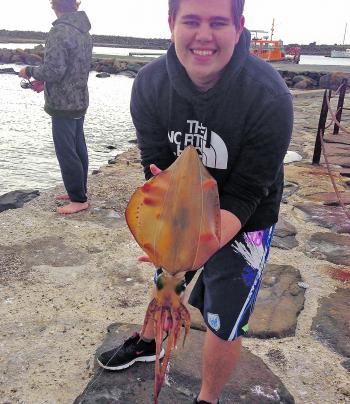
Low Head land-based squid bring the smiles for miles.
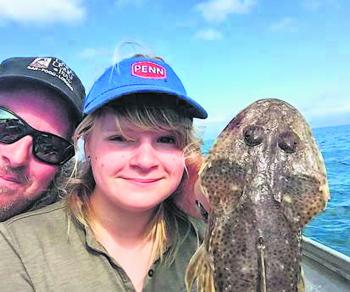
Three heads are better than one when it comes to family fun.
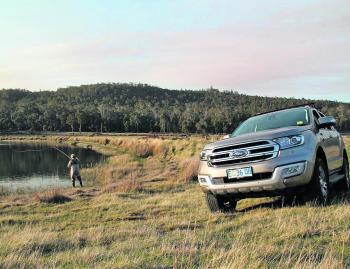
Tasmania is a perfect place to throw some perfect loops.
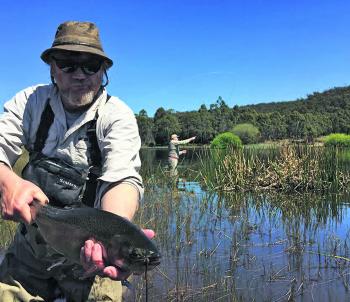
December means sunny days and lots of insects.
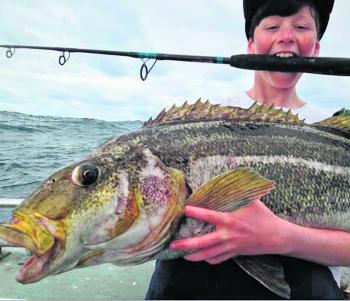
No need to eat the rod anymore, a trophy striped trumpeter will fill the fridge.
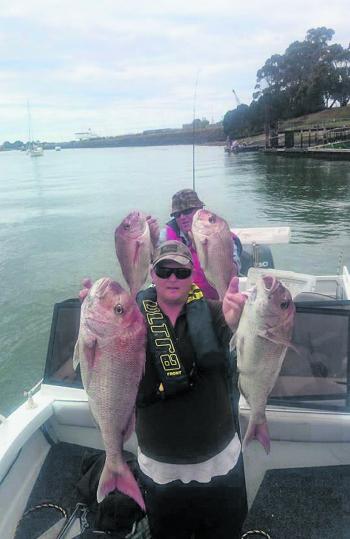
Snapper can be a tricky nut to crack in Tassie, but if you stick at it, you’ll have handfuls of red in your boat!
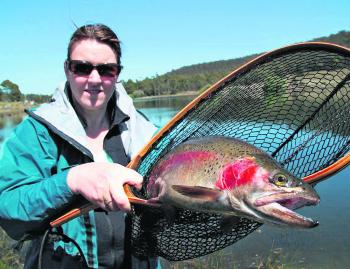
Big lake trout feeding around the edges are a summer specialty.




